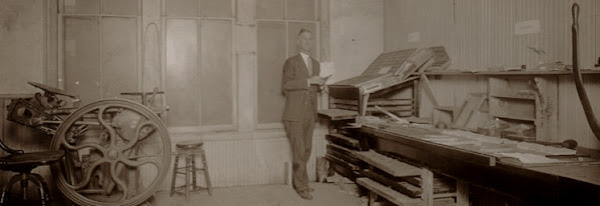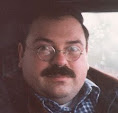I posted here how I recently traded in the 8x12 Old Style for a 10x15 Old Style that I restored. In this case I had steel trucks but the rollers were all bad and again, I couldn't afford to buy new ones. Fortunately my friend Alan recently loaned me three rollers from one of his presses, two of which I have and the other I mistakenly left in his shop. I had adjusted the platen for a standard packing as I've described in an earlier post and all that remained was to compensate for the fact that on this press, as on many older presses, the rails were manufactured less than type high. In the case of Chandler and Price, 1/16" less. This weekend I was determined to get the press printing so I could begin some of the projects that I've been wanting to do.
The steel trucks I got with the press were 1/16" oversize from the standard that came with the press when new, meaning that they were 1 3/4" diameter. They are actually stamped "oversize" on the sides. C&P offered oversized and undersized trucks as options according to their early catalogs. The rollers that came with my press when I got it were therefore 1 5/8" diameter so they would be type high. My friend Alan has a 10x15 New Style the rails of which were also 1/16" below type high. He had been using the rollers he gave me on that press which are 1 3/4" diameter and, since the steel trucks he was using were the the normal diameter trucks C&P supplied with the press, 1 5/8" diameter, he had taped both the trucks and the rails to bring them to type high. So in order for me to use his rollers with my trucks I would only need to increase their height by 1/16". I decided to do this by taping the rails.
I know there is special tape sold to do this but of course that costs money. I thought long and hard about what kind of tape I wanted to use. My friend had used duct tape with good results but I decided to try something different. I bought some metal tape at the hardware store, the kind used to tape the joints of metal ducting; basically metal duct tape instead of cloth duct tape. The metal is very thin and easily cut. I decided to use this because I thought it would provide a firm, smooth surface that could be more finely adjusted because the tape is so thin.
I measured the length of the rails and then cut the tape into 24" lengths, slightly longer than needed. The roll of tape is about 2" wide so I cut these lengths to the rail width of 5/8" on my 26" paper cutter. The knife went through like butter and because of the thinness of the metal and the buffer between each layer the adhesive and backer provided I don't think it affected the edge much. In any case, the knife is almost due to be changed anyway.
One by one I laid the strips on the rails. I started with 10 layers per rail and then started checking the height with a straight edge laid across both rails and a type high gauge as I added more strips one by one. When I got it just about right with the gauge I put the rollers on the press and used them with the type high gauge for the final adjustments. I stopped when I could feel a bit of pressure on the gauge from the rollers. In the end it turned out that the left side required one more strip than the right. As I was making the final checks, I ran the press for a bit to press the tape down well and avoid movement through compression later. I was pleased with the end result. Since the tape is metal it doesn't stand out like a sore thumb; it's smooth and hard; and should I need to make adjustments later it will be easy to do so. It was also inexpensive: the roll cost about $3 and I have enough left for at least two more presses.
Of course, the proof is in the pressing. Today I locked up my business card form and inked up the press and pulled some proofs. I was very, very happy with the results. The photos below will show the reason. I used my standard packing only with no makeready. Now a small form should probably need little to no makeready anyway but the fact that it inked and printed so well right off the bat was very encouraging to me. This is especially true after my experiences up to this point with the limitations of my old trucks and rollers. I was also pleased that my platen adjustment seemed to be just right. Naturally when I print a larger form problems may show up but I'm certainly satisfied at this point.
The top photo shows a proof pulled on a lightweight bond paper. I used Strathmore 100 percent cotton laid paper for the proof in the middle photo. I had difficulty with that paper before with my old press so wanted to try it again now. Needless to say, it looks really good. There is a speck of something on the R in my name from the scanner. I decided to try something larger so locked up the cut shown in the bottom photo which is about 3 1/2" x 6". Again, there was no makeready and I thought it came out pretty good, a nice even print at least. The cut is damaged on one corner so there is a break in the border at that point. I'm also afraid the scanner added some bands of color to the photo: oh, well. These photos may not show the details sufficiently so I'll probably post them to Flickr where they can be enlarged.
Now I need to pick up that third roller and then start on my projects.






5 comments:
Your press is SO wonderful to look at. However, how did you prepare for such a large weight in a residential main floor? What about the vibration?
Thank you; and excellent questions. The room the press (about 1200 pounds)is in is about 12' x 15' with a 3/4" tongue and groove wooden floor directly on 8" joists running the short distance. In the center of this span and directly in line with the press I have in the basement an adjustable lally column (purchased from Home Depot) supporting a hardwood beam 3" x 9" x 48" long that spans four joists, which is wider than the footprint of the press. The lally column is resting on a slab of iron to distribute some of the weight on the concrete floor. A stone or concrete block would have worked also. My 26" paper cutter (about 800 pounds)is at the other end of the room and I have a similar setup for that.
Both the press and cutter are on heavy hardwood runners which distribute their weight and of course the weight is already somewhat distributed over the dimension of the footprint of each machine.
I've read comments about people's presses vibrating but I haven't experienced it myself, at least not to the extent one is lead to believe it happens. When my press is running (14 impressions per minute) and you place your hand on it you can feel it "vibrating", but it's very minor. In general it runs very smoothly. If I increased the speed I'm sure it would vibrate more, but I think it would have to be running faster than one could feed it before it started vibrating enough to cause any kind of problem. So at least in my case this hasn't been an issue.
Congratulations on getting the press printing! It looks great and it must be wonderful to finally get started.
The metal tape is a great idea and your description of building up the rails was probably the clearest on I've read. If and when I do get a bigger press, I'm sure I'll refer to this post.
Can you tell me what the typeface you're using for your name and location is? I have some of it in various sizes (it came with my press and was very dirty!), but I hadn't yet gotten around to figuring out what it is.
-Maggie
gamewellpress.typepad.com
Thank you for the comments, Maggie. You actually deserve the credit for inspiring me through your blog to be more detailed in my posts.
The face is Stymie, I believe designed around the turn of the century. From what I gather it doesn't seem to be very popular with printers but I happen to like it because I think it has a nice vintage look.
Thanks, Rich.
Well I looked up Stymie in McGrew's last night and it isn't the same face as mine, so I'll have to keep searching. My lowercase gs and uppercase Js are different, but otherwise the two faces seem so similar.
I like the font too and have been using my mystery font on calling cards for a friend.
Post a Comment